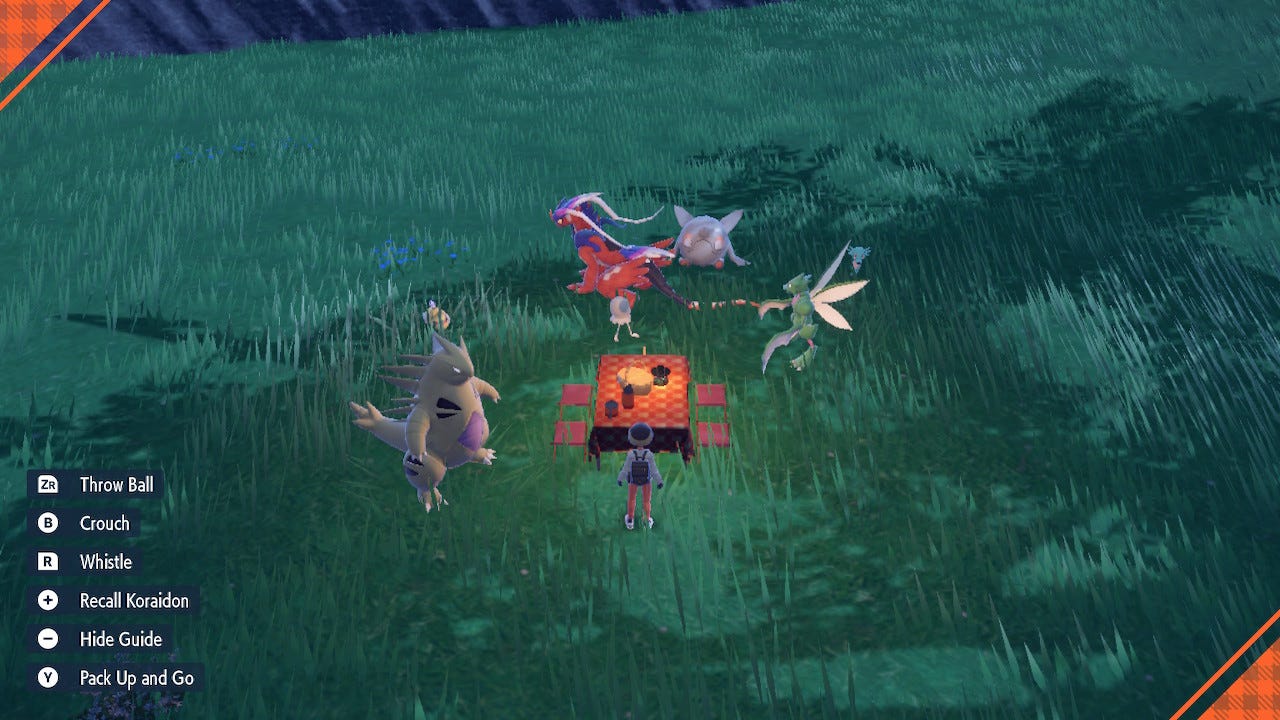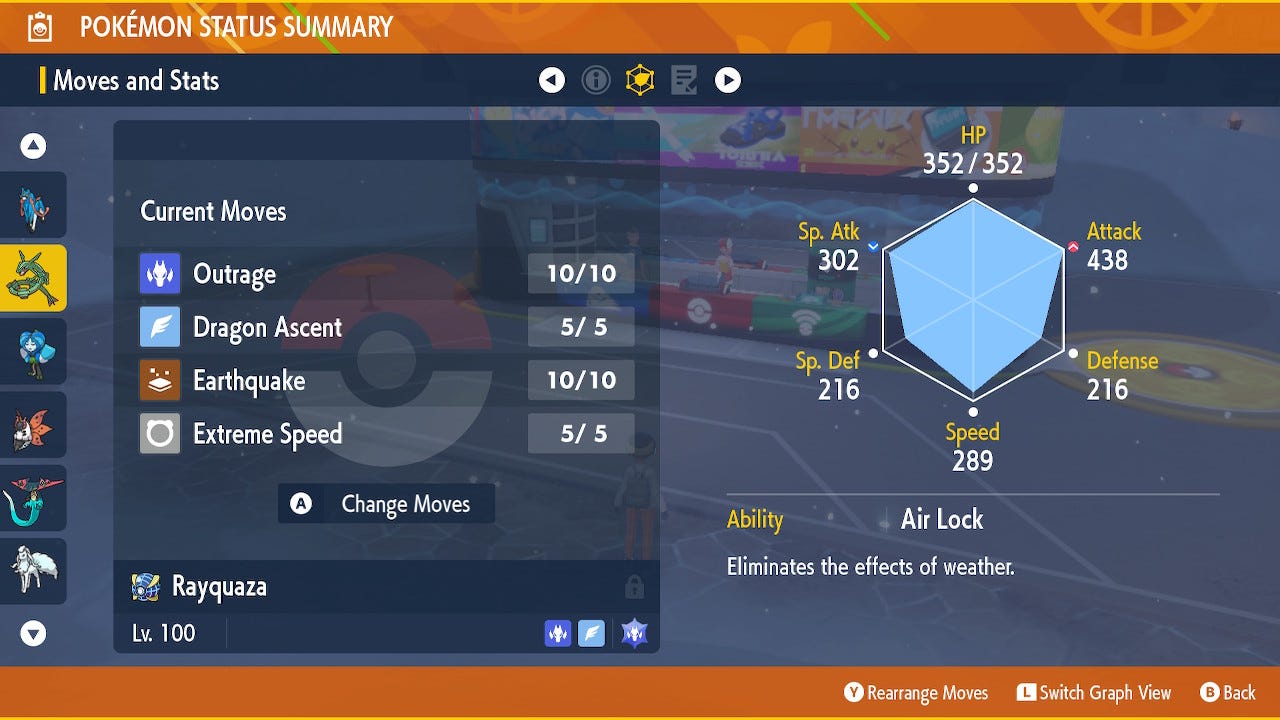What is BST?
Or Why More People Aren't Using that Shiny New Rayquaza
BST is a common term in Pokémon, competitive or otherwise, and most active players probably know it already. Just in case, BST is shorthand for a Pokémon’s Base Stat Total, which has a wide range from Pokémon to Pokémon. Fun fact, the current lowest total is 175, held by the honorable Wishiwashi (at least until it transforms), and the highest goes to Eternamax-from Eternatus, which… can`t actually be used. Leaving off special forms, the proper highest would be a base of 720, which is held by Arceus. Makes sense, seeing as it’s the divine God who created the universe according to Pokémon lore.
I’m sure this is obvious, but a Pokémon’s BST is kind of important in the VGC world. However, only having a high BST isn't good enough. The most important part of a Pokemon’s BST is how those points are actually distributed from stat to stat, regardless of what the overall total is. As cool as a mythical flying dragon is for example, there’s a reason the beloved Rayquaza doesn’t see much competitive play, even with 150 points in both Attack and Special Attack.
Now some readers may be thinking, “But wait, that seems pretty high. Why wouldn’t having a great Attack and Special Attack be a good thing?” Unfortunately, as many players familiar with VGC will tell you, having two high Attack stats usually means valuable points are lost in other stats, significantly bringing down a Pokémon’s speed and defensive prowess. The vast majority of teams in VGC will build each Pokémon with a focus on only one of its attacking stats. A lower stat total in the unused attacking stat means more of the Pokémon’s total points can be allocated to other stats instead.
Let’s take a deeper look at Rayquaza, for example. Some people may be wanting to use it given the recent shiny event that just took place in Scarlet and Violet. And let me be clear, you absolutely can see success with it! It’s a strong Pokémon with some powerful, unique tools that let it hit hard and blast holes through unprepared teams. However, Rayquaza also has some key factors working against it that a player must take into account when making it the centerpiece of a team. Its typing (Dragon/Flying means a 4x weakness to ice moves) can’t be ignored, but more important to our discussion, its BST of 680. While high on paper, that leaves a lot to be desired with an evenly split Attack and Special Attack. While those are both a sky high 150, its speed is a paltry 95 by comparison. Lower speed might be okay if it has a lot of HP, Defense, and Special Defense to make up for it. In Rayquaza’s case, those are 105, 90, and 90 respectively. Not terrible at all, but you can’t help but hope for better with a speed of only 95.
To add a little more context, let’s compare Rayquaza to the other two Restricteds from its generation, Groudon and Kyogre. These two have a slightly lower BST, at 670, yet they’ve both seen far more success historically in VGC.
Rayquaza: HP/105 Attack/150 Defense/90 Sp. Attack/150 Sp. Defense/90 Speed/95
Groudon: HP/100 Attack/150 Defense/140 Sp. Attack/100 Sp. Defense/90 Speed/90
Kyogre: HP/100 Attack/100 Defense/90 Sp. Attack/150 Sp. Defense/140 Speed/90
Okay, I`d be remiss to leave out that the other two do also have the benefit of game-warping abilities that force players to play around them at all times, but you may also notice a problem forming by looking at their BST. Even if one doesn’t train those stats, they each have at least one defensive stat that is significantly higher than Rayquaza’s without any training up at all. Their HP and speed are a smidge lower, yes, but the other defensive stats are identical. In the end, despite having lower BSTs overall, Kyogre and Groudon both have access to more points overall in the stats that they are actually using. It might be a little less exciting when you break the Pokémon down into numbers like this, but cutting away 50 points from each of their unused offensive stats means that they have 50 extra points to use somewhere else. Forty if you want to factor in them also having slightly lower overall BSTs.
There are even more, better examples of this if we leave Generation III and jump ahead to Generation 8 (Sword and Shield), the king of power creep. It gave us comically broken Pokémon such as Urshifu, Calyrex-Shadow Rider, and the most offensive, Zacian. This Pokémon’s stat spread was so absurd that they nerfed not only its stats, but its ability going into Generation 9. Once again, let's take a look at its stat breakdown, and keep in mind, this is the angry dog`s stats after it was nerfed into oblivion by Game Freak.
Zacian: HP/92 Attack/150 Defense/115 Sp. Attack/80 Sp. Defense/115 Speed/148
Again, this is after the dog got nerfed (really, really hard). Despite this nerf, it still has a BST of 700 (down from 720), an offensive stat equal to Rayquaza’s, higher defensive stats across the board, and is blazingly fast. The only thing Rayquaza has on it is a slightly better HP stat. Whoopee. And this is where we really see the problem. Take away extremely powerful abilities like Kyogre or Groudon’s weather setting, and the BST has to do a lot more work to make the Pokémon viable. To be fair, Zacian also has a pretty good ability, but as it got a significant nerf going into Gen 9, its stats have to carry it much more than in the past. Luckily (for it anyway), it has a brilliant stat spread, allowing it to not only out speed a significant percentage of the entire game`s Pokémon, but also survive major attacks from other Pokémon.
This is something you’ll see over and over again among Pokémon that see the most success in VGC. While it is not at all the only factor, having a good BST spread goes a long way in lifting a Pokémon above its peers when fighting it out in competitive battling.





